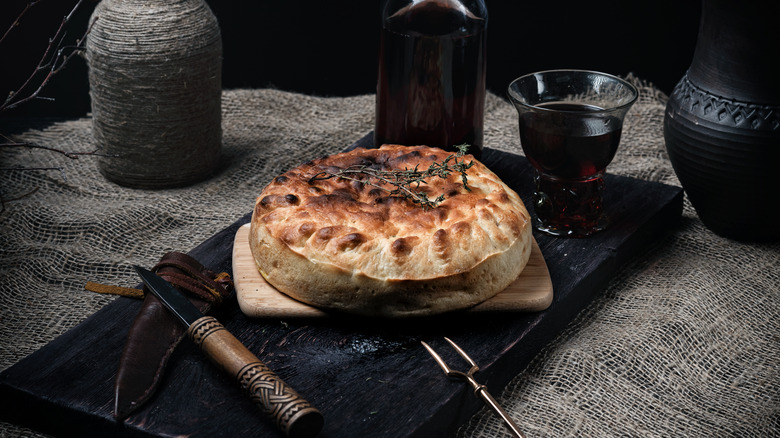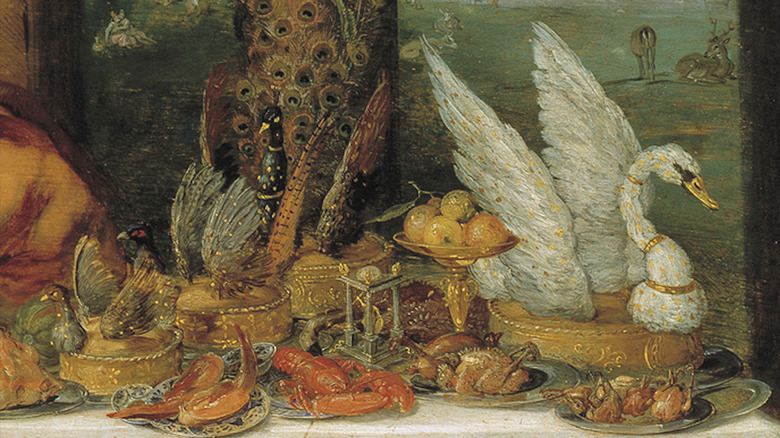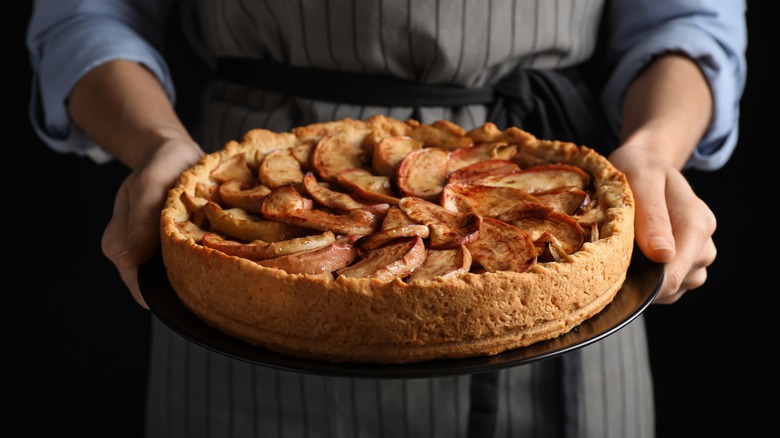Here's What The World's Oldest Pie Tasted Like
In ancient times, coffyns — one of the earliest names for the pastry containers that would eventually evolve into modern pie crust — were stuffed with poultry, often with legs and all hanging out the sides of the crust. The earliest pies were savory in nature, and as far as the dangingly-legs thing goes, that apparently made the pies easier to pick up. Think chicken drumsticks packed in crust, and you kind of have the right idea. And while it's true that the Brits, who gave us words like "coffyn" and "pyes," did enjoy savory meat pies, it's actually thought to be the ancient Egyptians back in 6000 B.C. who foisted the earliest precursors to pies upon the world. It seems that ancients in many cultures liked umami-leaning pies, though sweet pies also made appearances on tables from the earliest times.
It was the Greeks who get credit for coming up with pie crusts, which for them meant a bit of flour mixed with water and fat. If those sound pretty tasteless to you, you're right. Taste didn't factor into early pie-crust equations. They were the dish the meat was served in, as well as a place of storage, and were often closer to pottery in consistency than the flaky pie crusts of today. In light of that, it just made sense for British pie parts to have names like "coffyn," and while "coffyn" became the modern word "coffin," it just denoted a box or a basket at the time.
What types of savory pies existed in the past?
Ancient pie cooks packed their pies with proteins to give their patrons something they could actually chew on. Lamb, beef, magpie pigeon, and duck appeared in the pies of the ancient English, who had the good sense to also put dates and currants, as well as pepper in the pies, to add seasoning and extra flavors. The ancient Romans introduced their love of seafood, and it wasn't unusual to open a Roman pie and find lamprey, oysters, or mussels inside, but goat cheese and honey weren't out of the question, either.
As for the early Americans, the pumpkin pies that have become synonymous with Thanksgiving probably weren't a thing just yet, at least not on that very first holiday. Fortunately for modern pie lovers in the United States, some beloved traditions did cross the pond with the early settlers, ensuring that the best kinds of savory pie recipes made it into the proverbial recipe box. As such, it's more likely that the early pilgrims, too, had savory pies, filled with meats like venison or different kinds of fowl, and flavorings of cinnamon, nutmeg, pepper, and dried fruit, making their pies a cross between fruit cake and pot pie, in a manner of speaking. And English pies certainly had a bright side. Shepherd's pie and cottage pie counted among their early pie recipes, even if pumpkin pie didn't.
When pies became sweet
Thankfully, early pie makers had the inclination to include ingredients like apples and pumpkin in their recipes so that modern apple pie and Mom and all that American jazz could eventually exist. Sweet pies go all the way back — again — to ancient Egypt, and their pies consisted of a flour exterior made from barley, wheat, oat, or rye and fillings of honey. By the time Ramses II made his way to the throne, pies had become more sophisticated. To the honey interiors, the Egyptians added fruits and nuts. Mankind had to wait until the 16th century, however, for sweet pies to really catch on. By then, cherry pies garnered the favor of Queen Elizabeth I, though strawberry pies also made their way into the cookbooks of the day.
But leave it to Colonial America, circa the 17th and 18th centuries, to perfect sweet pies and to create a whole pie belt — aka New England — in the process. With access to ingredients like maple syrup, honey, molasses, and cane sugar as well as fruits like pears, blueberries, pumpkins, and apples, sweet pie (and the edible crusts everyone loves so much) became such an important food that people ate them for breakfast. Old-world pie-eating came to an end in the 19th century when a health movement encouraged people to stop eating pies. That lasted until the mid-20th century when people finally came back to their pie-eating senses and began eating sweet pies once again with a vengeance.


